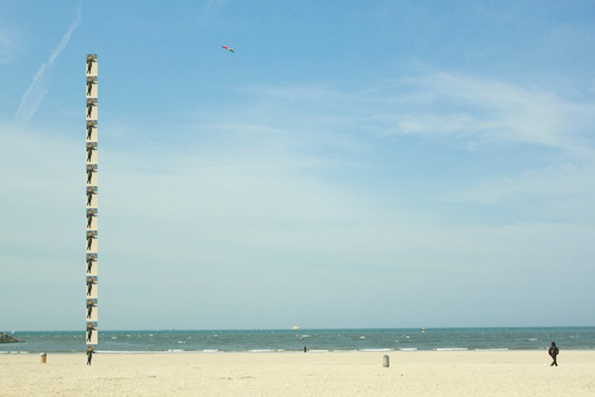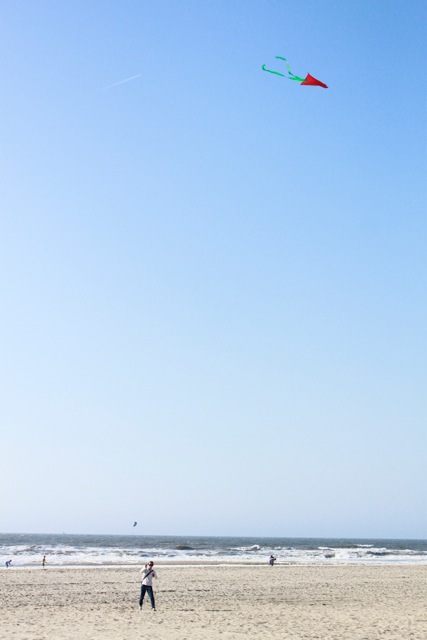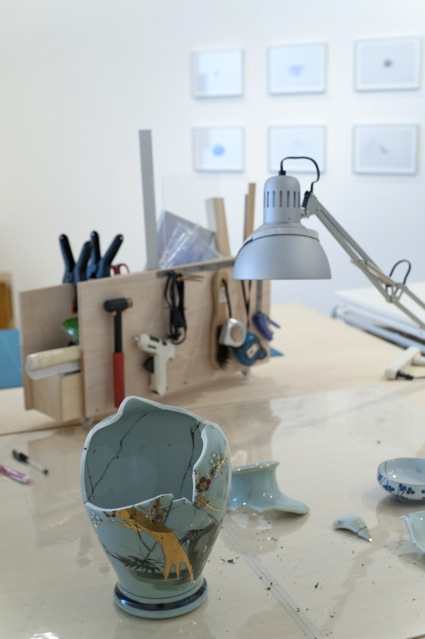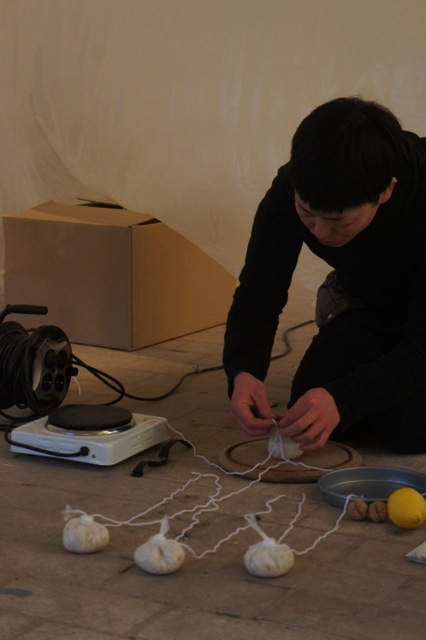Nishiko & Sachi Miyachi @Badgast
| 2013-03-27 08:52:15
'Repairing earthquake project, third phase' by Nishiko
& 'The scope in the swell waves' by Sachi Miyachi
April and June Nishiko & Sachi Miyachi are artists in residence @ Badgast.
www.nishiko55.com/eq | www.sachimiyachi.com
Installation 'Current washes ashore' (2013)
Exhibition ZEELUST at GEMAK, THe Hague 24/5 - 2/6 2013
Found objects, sea sand, seawater, rainwater and photography. Collaboration between 'The scope in the swell waves' by Sachi Miyachi and 'Repairing earthquake project, third phase' by Nishiko.


During the residency at Badgast in Scheveningen from April till May in 2013, we took time to explore and imagine the impact of the sea on humans and the world we live.
To get a sense of our new working environment, we started by walking around under the ever changing weather conditions of the Scheveningen beach, photographing and observing people in their leisure time. Nishiko was interested in what objects would be washed ashore and in their reperation. Miyachi was concerned with the cycle of water, and its role in the distinction of minerals and sand.
Since the residency program is the part of both our ongoing projects, starting from the earthquake and the tsunami disaster in Japan in 2011, we thought of the threatening side of the sea. This aspect of the sea is also deeply rooted in the history in the Netherlands (the flood in 1953, delta project and so forth). Following the news of tsunami debris traveling from Japan to the North American Atlantic's west coast, we encountered the issue of microplastics that has been threatening the oceans. We thought about how the substances circulate in the sea and how small particles in the sea can have an immense environmental impact as a whole.
We blended the discoveries, activities and thoughts in the installation at GEMAK. Small objects were collected from the beach and harbor in Schevenigen: sand, sea water, distilled sea water, sea salt, rain water and garbage (abandoned and washed ashore) are carefully treated or sorted out, and displayed according to color.
FINISSAGE @ BADGAST JUNE 7 2013

21.1 m: Japanese tsunami height kite flying at Scheveningen: http://nishiko55.com/eq/
‘The scope in the swell waves’ by Sachi Miyachi
This project is based on my two-year long investigation into concepts of ‘catastrophe’ and ‘renewal’, spanning many cultures, eras, and contexts. This project explores and invents its own imaginary strategies for ‘recovery’, with a view for the sustainable development of life – both in physical form and in mental wellbeing. My starting point is the simple question: How can we transform things for the better? This leads me to consider the processes by which we re-define the meanings and values behind human creativity – how we can continue to celebrate living whilst being confronted by scenes of destruction: natural disasters, climate change, economic crisis, nuclear threat and world wars.
The Great Eastern Japan Earthquake of March 2011 has brought about the issues that arise through the ‘myth’ of modern technology and a highly organized society and the relationship with maintaining an untouched nature. The fact is, that has been demolished instantly, and transformed into huge amounts of debris that is now littering the ocean current and will take thousands of years in the decomposition process. This earthquake event and the diverse issues that arise from it, makes me have a new perspective on our society from the dynamic view of nature to consider the possible ways we may take the long term cycle of our material world and our daily lives into consideration.
I have been working with guest collaborators for my investigation. As a continuation of this project, I will collaborate with Nishiko who I have found a strong link between our approaches and we have been exchanging information and knowledge for a year now. We plan to engage with each other’s projects and catalyze a possible collaborative work through the Badgast project. All of our activity will be documented in order to create an archive to overview our actions during this process.
‘The Repairing Earthquake Project’ by Nishiko
The Repairing Earthquake project is an art project initiated by Nishiko dealing with the extensive natural disaster, the Great Eastern Japan Earthquake, which took place in Japan in March 2011. I have been finding objects and things at the disaster area that have been destroyed in the tsunami and repairing them in the temporary studios.
The materials of the objects are roughly categorized into five sorts: wood, tableware, metal, plastic and glass. Each object requires different way of repair depending on the material and the state of the damage. It is important for me to repair objects in the way so that one can trace how the event took place even after an object has been repaired. For instance, the cracks will remain apparent after pieces of a destroyed object are glued back together and the fillings of holes and an unmasked surface of a corroded metal object should remain in order to leave the traces of its history and hand down the story of this devastating disaster that still suffers severe after effects. The dialogues and interaction with people in the affected areas and audiences in the repairing session are fundamental for myself, as I did not experience the disaster; through the project I am trying to relive their experiences.
The first phase took place September-November 2011, in “Shin Minatomura BankART Life III”, a related programme of the Yokohama Triennale 2011, the second phase took place in the exhibition ‘After the Disaster: Progressing Documentation’, at the Contemporary Art Center, Art Tower Mito in Japan from 13 October until 9 December 2012.
The Repairing Earthquake Project the third phase by Nishiko
The third phase of the Repairing Earthquake Project will be in collaboration between ‘The Repairing Earthquake Project, the third phase’ and ‘The scope in the swell waves’. The final goal of this collaboration is to follow the flotsam of the disaster making its way to American and Canadian shores recently, and repair it.
The residency program at Badgast is the starting point of this collaboration. We will utilize this time as a laboratory to learn about the larger subject we are facing. Our focus at Badgast will be based on the impact of a tsunami, hydrologic cycle and ocean current. We will make experiential studies of these themes and conduct various activities in rather small scale. As we expect to meet surprises that inspire us during the stay at Badgast, we decided not to plan much but be flexible and work intensively at the location. The subjects we are interested in are reading weather, marine debris at the port of Scheveningen, high waves at sea, wind power, water management in the Netherlands, mapping the ocean current, survival technic stories of flood in legends and religions and such.
We admire the fact that the principle of the nature is actually logical but yet incomprehensible because of its vast scale. In order to understand it better, we would like to dissect this subject, and shrink it to the small scale that we can observe the whole. As the starting points of the project we set two plans to realize: flying a kite to the height of the tsunami reached in the disaster, and to make a construction, where we physically observe the water cycle of the ocean in a work using distilled sea water that runs into a river which will turn into a cup of coffee.

Repairing earthquake project, second phase (2012) - Nishiko
“Artists and the Disaster - Documentation in Progress” Installation view at Contemporary Art Gallery, Art Tower Mito. Photo: Yuzuru Nemoto.
Courtesy of Contemporary Art Center, Art Tower Mito.

The scope in the swell waves (2012) - Sachi Miyachi
Translation courtesy Quynh Vantu.
